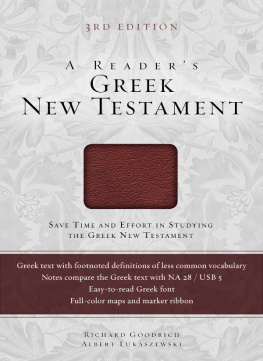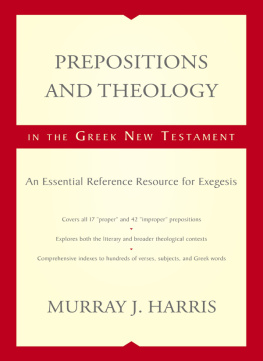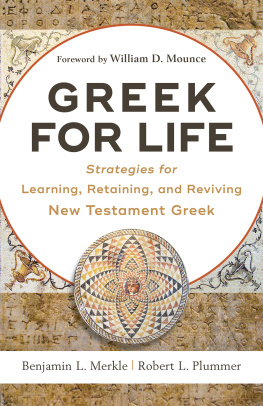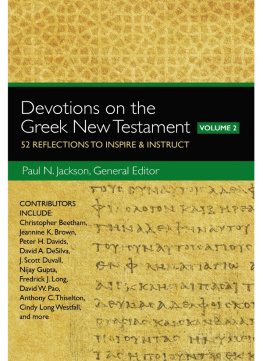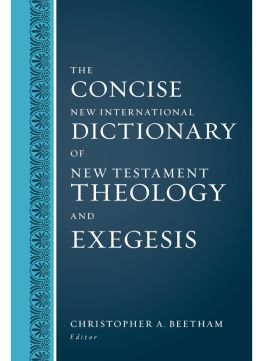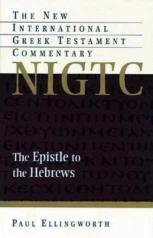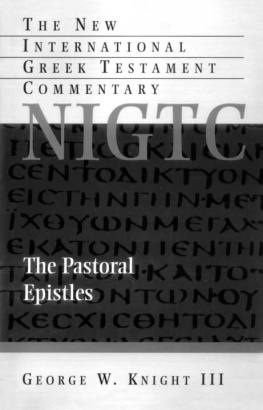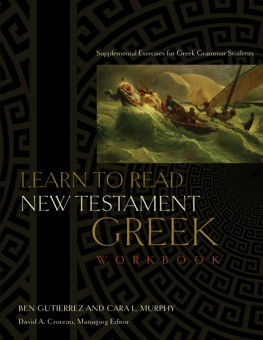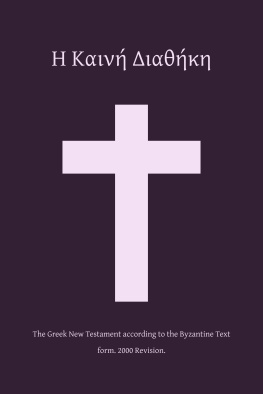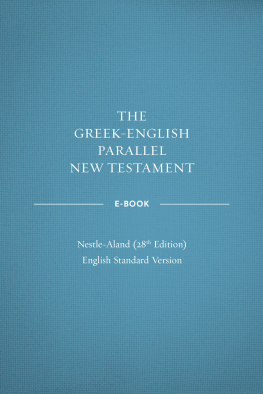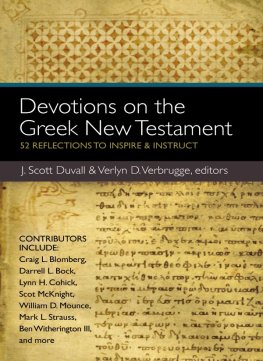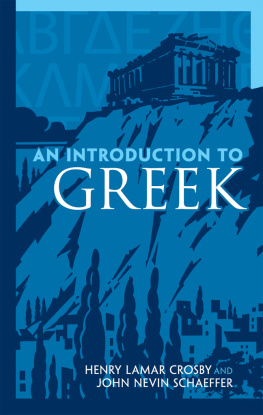ZONDERVAN A Readers Greek New Testament: Third Edition Copyright 2003, 2007, 2015 by Richard J. Goodrich and Albert L. Lukaszewski Requests for information should be addressed to: Zondervan, 3900 Sparks Dr. SE, Grand Rapids, Michigan 49546 ePub Edition November 2015: ISBN 978-0-310-52147-1 Library of Congress Control Number: 2015939694 The Greek text used in this edition of the Greek New Testament was originally developed for the Portland Index Project by Edward W. Goodrich and John R. Kohlenberger III, and subsequently reviewed and modified by Gordon D.
Fee and Douglas J. Moo. Any Internet addresses (websites, blogs, etc.) and telephone numbers in this book are offered as a resource. They are not intended in any way to be or imply an endorsement by Zondervan, nor does Zondervan vouch for the content of these sites and numbers for the life of this book. All rights reserved. Interior design: Richard J. Interior design: Richard J.
Goodrich and Albert L. Lukaszewski 15 16 17 18 19 20 21 22 23 24 /CTC/ 20 19 18 17 16 15 14 13 12 11 10 9 8 7 6 5 4 3 2 1 Table of Contents In the first edition of the Readers Greek New Testament, (published in 2003), we noted a growing interest in Koine Greek. Over the past twelve years, the demand for Greek resources has continued to expand: publishers of biblical Greek teaching materials enjoy strong sales, and every year we see additional resources introduced to support Greek learners. Seminaries and Bible colleges have found their Greek courses attracting more students. Beyond the walls of the academy, countless numbers of small groups of independent learners meet in homes and churches to learn the language of the New Testament. The pool of Greek readers in the early twenty-first century is flourishing.
This renaissance is especially amazing considering the difficulty of the task. For most, the acquisition of a second language requires a significant investment of time and effort. Moreover, Koine Greek is not one of the easier languages to learn. It may take years of study before a student is able to simply sit in an armchair and read the Greek New Testament. We are always inspired when we reflect upon all of the students who are dedicating themselves to this challenge. One of the great barriers to reading is the problem of vocabulary acquisition.
The student who enrolls in a seminary Greek course will spend a significant amount of time learning how Greek words change form depending on their role in a sentence (inflection) as well as how those words are arranged to express an idea (syntax). Vocabulary acquisition often emerges a distinct third among course objectives. The textbook and the emphasis placed on memorization by the instructor will determine the number of words a student will learn in a Greek course. A typical textbook, William Mounces Basics of Biblical Greek, teaches all of the vocabulary words that occur fifty times or more in the Greek New Testament. The student who memorizes Mounces selection of 319 words will know 79.92% of the words found in the Greek New Testament. In other words, the student will recognize 4 out of every 5 words.
Unfortunately, this is not as great an advantage as it might seem at first sight. Of the 110,425 memorized words, 29,023 are the Greek words for the () and and (). More than 26% of the words a student will recognize in the text are the two most common words. In fact, by learning the words that occur fifty times or more, the student will have only learned six percent of all the lexical forms found in the Greek New Testament (319 out of 5,437). This leaves 5,118 words that the student will not know. These unfamiliar words occur 27,737 times in the New Testamant text.
Although the odds still seem to be tilted in the students favor, the advantage is dispelled when we consider the impact of these 27,737 words on someone who might want to read through the Greek New Testament. Simply dividing the number of unrecognized words by total verses (27,737 / 9,942) reveals that on average, each verse will contain 3.5 words that the reader will not recognize. Let us assume that a student has decided to read through the Greek New Testament over the course of a year. In order to achieve this goal, the student will have to read about 22 verses each day. If each verse contains 3.5 unfamiliar words, then the student will have to consult a lexicon, on average, 77 times per day. If we assume this reader is very quick with a lexicon, and can look up each word in 30 seconds (much faster than most people could), the reader will still spend more than 38 minutes every day looking up words.
If we add this time to the time spent puzzling over verb forms or wrestling with the syntax of sentences, it quickly becomes evident that a daily reading of the Greek New Testament is going to require a significant investment of time. The simple joy of sitting and reading the Greek New Testament (as one would read an English translation) requires a much larger vocabulary base than the words that occur fifty times or more in the text. How does one acquire this vocabulary base? The traditional approach is to press on learning vocabulary until all or nearly all of the vocabulary words that occur in the Greek New Testament have been memorized. A student who can memorize (and retain) 10 words per day should be able to master all of the vocabulary in slightly less than two years. For those who have the time and discipline to devote to this task, this is certainly the best path. Unfortunately it requires a commitment that most people will not have the time or energy to make.
This text, A Readers Greek New Testament, offers a second path to vocabulary acquisition. We have designed it to open the Greek New Testament to those readers who possess a limited vocabulary. This is achieved by defining (in footnotes) every word that occurs less than 30 times in the text (words occuring more than 30 times are listed in a short lexicon at the end of this volume). When the reader encounters an unfamiliar word in a verse, a simple consultation of the definitions at the bottom of the page will stand in for a trip to the lexicon. The reader with a limited vocabulary can now focus on understanding and reading the text, rather than spending valuable reading time looking up words. It is also hoped that the use of A Readers Greek New Testament will foster an inductive approach to vocabulary acquisition.
The brute memorization of flashcard words is replaced by a more natural form of learning. By reading large sections of text, the student will be immersed in the language and absorb words as they unfold in the context of sentences. The Text The Greek text presented in A Readers Greek New Testament is the eclectic text that underpins the New International Version. The Greek text for its predecessor, the New International Version, was compiled by Edward Goodrick and John Kohlenberger III. a few words to clarify these differences are in order. As any student of the New Testament will know, our evidence for the initial text of the Greek New Testament is found scattered among a great number of manuscripts, manuscript fragments, and pieces of papyri that have survived from antiquity.
Employing these diverse witnesses, textual scholars have reconstructed the source texts that became the New Testament as we know it. There are some points, however, where the manuscript traditions favor different readings. When these divergences were encountered, the UBS editorial committee decided which variant reading to include in the text. This selection of the correct variant did not always have the support of the entire committee, and at best represents a compromise solution. The critical apparatus included with modern versions of the Greek New Testament alerts the reader to the possibility of other readings. One of the preliminary tasks of any translator is to review the variants found in a source text.
Next page
